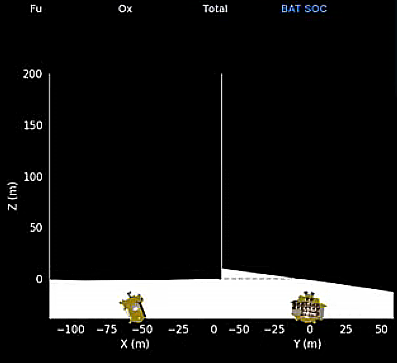SLIM lands on the Moon

According to telemetry data (as shown on the screen capture to the right), Japan’s SLIM lander has apparently landed on the Moon near Shioli Crater, proving its autonomous precision landing system worked as planned.
At the moment however Japan’s space agency JAXA has not yet confirmed that the landing was completely successful. After landing the announcers on the live stream repeatedly noted that though the telemetry indicated it had landed as planned, engineers had not yet confirmed that the lander was still operational. Note how the data to the right suggests the spacecraft is tilted slightly. This tilt appears to match the tilt of the surface, but it could also indicate a problem with communications.
A press conference announcing either a confirmation or a failure will begin shortly at the live stream above.
On Christmas Eve 1968 three Americans became the first humans to visit another world. What they did to celebrate was unexpected and profound, and will be remembered throughout all human history. Genesis: the Story of Apollo 8, Robert Zimmerman's classic history of humanity's first journey to another world, tells that story, and it is now available as both an ebook and an audiobook, both with a foreword by Valerie Anders and a new introduction by Robert Zimmerman.
The print edition can be purchased at Amazon or from any other book seller. If you want an autographed copy the price is $60 for the hardback and $45 for the paperback, plus $8 shipping for each. Go here for purchasing details. The ebook is available everywhere for $5.99 (before discount) at amazon, or direct from my ebook publisher, ebookit. If you buy it from ebookit you don't support the big tech companies and the author gets a bigger cut much sooner.
The audiobook is also available at all these vendors, and is also free with a 30-day trial membership to Audible.
"Not simply about one mission, [Genesis] is also the history of America's quest for the moon... Zimmerman has done a masterful job of tying disparate events together into a solid account of one of America's greatest human triumphs."--San Antonio Express-News

According to telemetry data (as shown on the screen capture to the right), Japan’s SLIM lander has apparently landed on the Moon near Shioli Crater, proving its autonomous precision landing system worked as planned.
At the moment however Japan’s space agency JAXA has not yet confirmed that the landing was completely successful. After landing the announcers on the live stream repeatedly noted that though the telemetry indicated it had landed as planned, engineers had not yet confirmed that the lander was still operational. Note how the data to the right suggests the spacecraft is tilted slightly. This tilt appears to match the tilt of the surface, but it could also indicate a problem with communications.
A press conference announcing either a confirmation or a failure will begin shortly at the live stream above.
On Christmas Eve 1968 three Americans became the first humans to visit another world. What they did to celebrate was unexpected and profound, and will be remembered throughout all human history. Genesis: the Story of Apollo 8, Robert Zimmerman's classic history of humanity's first journey to another world, tells that story, and it is now available as both an ebook and an audiobook, both with a foreword by Valerie Anders and a new introduction by Robert Zimmerman.
The print edition can be purchased at Amazon or from any other book seller. If you want an autographed copy the price is $60 for the hardback and $45 for the paperback, plus $8 shipping for each. Go here for purchasing details. The ebook is available everywhere for $5.99 (before discount) at amazon, or direct from my ebook publisher, ebookit. If you buy it from ebookit you don't support the big tech companies and the author gets a bigger cut much sooner.
The audiobook is also available at all these vendors, and is also free with a 30-day trial membership to Audible.
"Not simply about one mission, [Genesis] is also the history of America's quest for the moon... Zimmerman has done a masterful job of tying disparate events together into a solid account of one of America's greatest human triumphs."--San Antonio Express-News


The figure on the graph looks like the spacecraft is upside-down, with the engines pointed skyward. This could explain the inability to confirm the landing and the apparent loss of signal from the lander. It was right side up as it landed, but then it turned over just after landing.
Watched a few minutes of the press conference. Apparently some trouble with the solar cells generating power. Possibly the panel is not aligned properly with the sun. The battery seems to have enough energy stored to operate for a while. I am curious why they do not use radioisotope decay thermal electric power generators? Based on no real knowledge, I would bet that anti-nuclear radiation phobia entered the decision
Paul Revere: No, I don’t think politics were a factor. Weight and cost were more likely the reasons. Moreover, the solar cells were also an engineering test, and it appears the failure is related the cells either not exposed to the Sun (failure to deploy) or an inability to transmit its power to the spacecraft.
Paul Revere,
As I recall, the general rule of thumb has been to use solar power out to Mars (and maybe the asteroids) and radioisotopes farther out. The Juno and Lucy probes at Jupiter and Jupiter’s Trojan asteroids, respectively, use solar panels, so either the practice has changed or I have misremembered.
Solar generates plenty of power at the Earth and Moon distance from the Sun.
Looking up the Galileo Probe to Jupiter, it seems there was a change:
https://en.wikipedia.org/wiki/Galileo_(spacecraft)#Electrical_power
Emphasis on “At the time.”